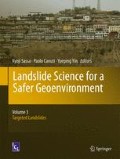Abstract
Batang County is located in Sichuan Province, southwest China, on the southeast margins of the Qing-Tibet plateau. A wide range of vegetation is distributed from the high altitude mountains to the deep gorges. Batang County is prone to debris flow, of which 151 debris flows were identified by remote sensing techniques (SPOT5) and field surveying in 2009. Based on geomorphology conditions, debris flows can be classified into 33 slope debris flows (SDFs) and 118 gully debris flows (GDFs). The SDFs vegetation coverage was significantly lower than the GDFs vegetation coverage. 72 % of the SDFs have a vegetation coverage below 50 %, and 70 % of the SDFs have a forest coverage below 10 %. However, more than 80 % of the GDFs have a vegetation coverage over 40 %, and only 35 % of GDFs have a forest coverage below 10 %. There is a negative correlation between the SDFs and vegetation coverage. This means that the lower the vegetation coverage, especially forest coverage, the more frequently SDFs occur. This correspondence relationship does not exist in the GDFs. Forest coverage excludes the impacts of shrubland and meadows, thus more accurately reflects the constraining effects of vegetation on debris flow. Vegetation controls debris flow in two ways. (1) Vegetation intercepts rainfall to reduce the volume and velocity of surface runoff, which decreases surface soil erosion. (2) Vegetation roots reinforce the soil, and increase soil shear strength. The primary cause of SDF is surface erosion. The roots of herbs, bushes and trees entwine together to form a dimensional anchorage net which reinforces soil integrity, increases resistance to erosion, and restrains movement by soil particles. The primary cause of GDF is landslides. When a landslide slide face is deeper than 3 m, vegetation roots are sparse, have no consolidation capabilities, and vegetation is ineffective at constraining SDF. However, GDF has multiple sources, and happens where the depth of soil is greater than 3 m. In this case, vegetation roots cannot fix the deeper soil body, thus GDF cannot be restrained.
Access this chapter
Tax calculation will be finalised at checkout
Purchases are for personal use only
References
Brardinoni F, Hassan MA, Slaymaker HO (2002) Complex mass wasting response of drainage basins to forest management in coastal British Colombia. Geomorphology 49:109–124
Chen H, Dadson S, Chi YG (2006) Recent rainfall-induced landslides and debris flow in northern Taiwan. Geomorphology 77(1–2):112–125
Chen JC, Lin CW, Wang LC (2009) Geomorphic characteristics of hillslope and channelized debris flows: a case study in the shitou area of central Taiwan. J Mt Sci 6:266–273
Evans SG, Guthrie RH, Roberts NJ (2007) The disastrous 17 February 2006 rockslide-debris avalanche on Leyte Island, Philippines: a catastrophic landslide in tropical mountain terrain. Nat Hazard Earth Syst Sci 7:89–101
Jakob M, Bovis M, Oden M (2005) The significance of channel recharge rates for estimating debris-flow magnitude and frequency. Earth Surf Process Landforms 30:755–766
Nettleton IM, Martin S, Hencher S (2005) Debris flow types and mechanisms. Crown Press, Edinburgh, 119p. ISBN 0-7559-4649-9
Pérez FL (2001) Matrix granulometry of catastrophic debris flows (December 1999) in central coastal Venezuela. Catena 45(3):163–183
Schmidt KM, Roering JJ, Stock JD (2001) The variability of root cohesion as an influence on shallow landslide susceptibility in the Oregon Coast Range. Can Geotech J 35(5):955–1024
Sidle RC, Ochiai H (2006) Landslides: processes, prediction, and land use, vol 18, Water resources monograph. American Geophysical Union, Washington, DC
Wei DL, Li YH (2012) The geochemistry analysis of debris flow sediment in the Quaternary at the east fringe of Qinghai-Tibetan Plateau. Res Soil Water Conserv 19(6):292–298 (in Chinese)
Author information
Authors and Affiliations
Corresponding author
Editor information
Editors and Affiliations
Rights and permissions
Copyright information
© 2014 Springer International Publishing Switzerland
About this paper
Cite this paper
Gao, Y., Ge, H., Xu, W. (2014).
 Control Effect of Vegetation on Debris Flows: A Case Study in Batang County, Southwest China.
In: Sassa, K., Canuti, P., Yin, Y. (eds) Landslide Science for a Safer Geoenvironment. Springer, Cham. https://doi.org/10.1007/978-3-319-04996-0_6
Control Effect of Vegetation on Debris Flows: A Case Study in Batang County, Southwest China.
In: Sassa, K., Canuti, P., Yin, Y. (eds) Landslide Science for a Safer Geoenvironment. Springer, Cham. https://doi.org/10.1007/978-3-319-04996-0_6
Download citation
DOI: https://doi.org/10.1007/978-3-319-04996-0_6
Published:
Publisher Name: Springer, Cham
Print ISBN: 978-3-319-04995-3
Online ISBN: 978-3-319-04996-0
eBook Packages: Earth and Environmental ScienceEarth and Environmental Science (R0)

